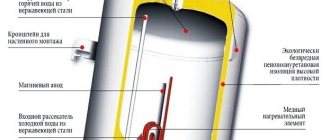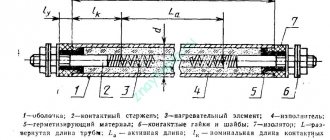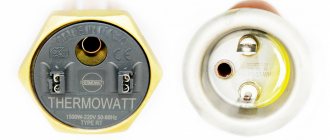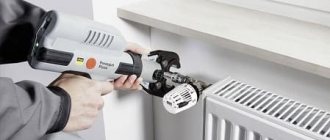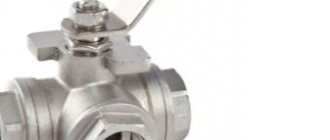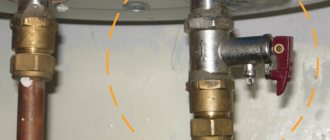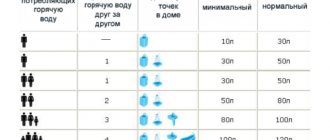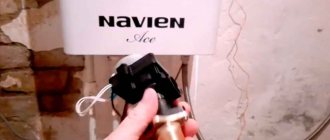Hot water is one of the necessary elements for a comfortable life. Where there is no centralized supply of coolant, boilers are used. In them, water is heated by heating elements, which can be dry or wet. Due to mineral deposits in the water or power surges, they become one of the most vulnerable points in the structure and fail. You can restore the operation of the boiler by installing a new heating element, and our rating of the best heating elements for water heaters will help you choose good models for each type of device.
Types of electric heating elements for heaters according to the principle of operation
There are two main types: “dry” and “wet” or closed and open. In the first case, the element is protected from contact with a heated medium. A typical option for the second type of heating elements is an electric kettle. The tube is located directly in the liquid reservoir.
Heating elements of closed or dry type
A nichrome or fechral spiral is placed inside a ceramic flask. A mandatory requirement is complete tightness. The heating element must always remain dry. The main materials for making flasks are magnesium silicate or steatite.
The rate of heating of water during use depends entirely on the thermal conductivity of the flask or casing.
The advantages of closed-type heating elements include:
- Safety, that is, if there is no defect in the manufacturing process, the likelihood of leakage and short circuit is excluded;
- maintainability;
- efficiency;
- long service life.
The last factor is due to the fact that the flange connection and the flask itself are covered with enamel. Thanks to this, the likelihood of scale formation is reduced, and the useful life increases by 2–3 times in comparison with “wet” types of electric heating elements.
A relative disadvantage is that closed heating elements are manufactured for a specific model of heating equipment. If, for example, a heating element burned out in a boiler, you will have to look for the same one. It will not be possible to replace it with an analogue one.
Open or wet heating element
These elements are not isolated from the heated environment. A spiral of nichrome wire is placed in a copper or stainless steel flask filled with quartz sand. It conducts heat perfectly.
Wet heating elements are classified into one of the groups, taking into account technical parameters:
- With or without anode socket.
- With fastening of the heating element using a nut or flange. The latter option can be injection molded or stamped.
- Straight or curved. The determining factor is the shape of the tank.
The advantages of these types of electric heating elements for heaters include quick set of the desired temperature. But it is necessary to remember a number of possible problems:
- the likelihood of a short circuit increases;
- plaque appears quite quickly, especially if the water has a high salt content;
- service life is shorter than that of dry type modifications.
Replacing a water heater heating element
Boilers have a fairly simple design and operate on a basic principle. If you don’t want to overpay the craftsmen for the work, then you can handle this task yourself. If your water heater is under warranty, you must contact the service center if all operating rules are followed.
Visual inspection of parts
A visual inspection allows you to objectively assess the condition of the heating element for the water heater. To do this, you will need to disconnect the boiler from the network, drain the water from it and disassemble it, cleaning the heating element from scale.
Inspect the part for cracks, chips, swelling or damage. If you find them, feel free to throw the item in the trash, as it will no longer be possible to repair it. In this case, the only option is to replace the heating element for the water heater with a new one.
This happens due to untimely replacement of the anode. Since after its destruction, the heating element itself and the walls of the boiler begin to corrode. It is extremely important: damage and leakage of the heating element will lead to damage to the thermostat, which will significantly increase the cost of repairs. If the heating element is damaged at the slightest level, it should be replaced immediately!
Tools for replacing heating elements
If a malfunction is detected, you need to prepare for replacement and purchase tools. Most of them are available in almost every home, so there should be no problems with replacement. So, to replace the heating element you will need the following tools:
- Wrench;
- Pliers or pliers;
- Absorbent fabrics (rags or napkins);
- Straight and Phillips screwdriver;
- Phase meter (screwdriver with indicator);
- New heating element.
Replacing the water heating element
Turn off the water supply by turning off the tap near the boiler. If there is no shut-off valve, turn off the water in the entire apartment by shutting off the riser. In addition to shutting off cold water, hot water also needs to be shut off.
The replacement process is quite simple, just do the work in the following order:
1. Draining water 1.1. Turn off the power supply to the device; 1.2. Make sure the water inside the appliance is at a safe temperature; 1.3. Turn off the cold water supply to the water heater; 1.4. Open the hot water tap on the faucet to relieve pressure inside the tank; 1.5. To allow air to enter the tank, open the shut-off valve on the tee installed at the hot water outlet of the water heater. If it is missing, it is necessary to dismantle the connections at the outlet of the water heater; 1.6. Connect the drainage hose directed to the sewer to the shut-off valve on the tee installed at the cold water inlet of the water heater and open it. If not available, a drainage hose must be installed at the inlet of the water heater. Water will flow out from the cold water supply point, and air will flow through the hot water connection point; 1.7. After draining, make sure there is no water inside the water heater. 2. Replacement of internal elements 2.1. Remove the cover of the device; 2.2. To replace the thermostat, slide it out of the socket and disconnect it from the power supply; 2.3. Remove the thermostat; 2.4. Unscrew the heating element or the heating element mounting using an open-end wrench, an adjustable wrench, or a gas wrench; 2.5. Wash the internal tank of the water heater and replace the heating element (anode and thermostat if necessary); 2.6. Assembly is carried out in reverse order. The main thing is to pay attention to the grounding wire.
Attention:
The magnesium anode is an integral part of the system for protecting the water-containing container and heating element (heating element) from corrosion. It is necessary to check the condition of the magnesium anode annually. If the magnesium anode is severely worn, it must be replaced. It is necessary to replace the magnesium anode at least once every 24 months.
Attention:
A tubular electric heater (TEH) is designed to heat water in an internal tank by converting electrical energy into heat. The formation of limescale (or scale) on its surface can lead to poor heat transfer, overheating or failure. Regularly inspect and, if necessary, remove scale from its surface using a descaling agent.
Types of heating elements for heaters, taking into account the spiral material
Most manufacturers of heating elements use fechral or nichrome to make coils. You can rarely find parts from Eurofechral.
Nichrome spirals remain plastic after heating and cooling cycles. Also they:
- have the highest possible resistivity;
- do not heat up during heating;
- withstands long-term use without deformation;
- do not burn oxygen during operation.
Heating elements with nichrome spirals can be removed, rearranged, repaired, and their sizes adjusted. They are used both in domestic and industrial heaters.
Fechral spirals can withstand high temperatures while simultaneously possessing significant resistivity. They are not destroyed under the influence of aggressive environments. Scale does not form on them. At the same time, they have good resistance to external mechanical influences and bending strength. They are mainly used in electric furnaces and heaters.
How to choose?
The operating time of the heater depends on many factors: operating conditions, power surges, etc. An open heating element operates on average for about 5 years, and the operating life of a wet heater reaches 10-15 years. When choosing a heating device, it is important to take into account the operating mode, frequency of technical work, volume of heated liquid, heating time, etc. etc. You can always get information on questions of interest from Polymernagrev specialists using the contacts on the website. We will carry out all the necessary calculations specifically for your water heater. You can also compare several types of heating elements and choose the best option for yourself.
Types of electric heating elements, taking into account the scope of application
Electric heaters are installed not only in boilers and electric kettles. They are used in the construction of thermal curtains, installation of molds, drying cabinets and other equipment for industrial and domestic purposes. In this case, both the shape of the heating element and its design may change.
Air heating elements
They can have either a smooth or ribbed surface. The latter option is more common due to the increased heating area. The maximum temperature does not exceed 4500C.
Models with fins were originally intended specifically for heating air masses, including those in motion. But some modifications are designed for installation in liquid tanks. Structurally, such a heating element is a tube with a round cross-section. Steel corrugated ribs 0.3 mm thick and up to 10 mm wide are attached to the outer surface in coils. Preference is given to stainless or carbon steel.
The fins not only increase the heating area, but also reduce the load on the spiral by 2.5–3 times compared to smooth options. The length of finned types of heating elements for heating is not standardized. It is selected taking into account the specific task. The same applies to the shape of the product.
Heating elements for heating water
Without heating elements of this type, boilers, washing machines, dishwashers, electric kettles, and autoclaves will not work. Their task is to heat water to a temperature not higher than 1000C. In a number of situations, if the tank has significant volumes, or liquid evaporation or steam production is required, cascades of heating elements are installed, connecting them in parallel or in series.
A mandatory element of a water heating element is a thermostat. It controls the temperature of the liquid and gives a command to turn on/off the equipment when it reaches a certain level.
The output ends of the spiral are covered with a dielectric sheath to avoid contact with water and short circuits.
Flexible heating elements
These types of heating elements for heaters are designed for installation in hot runner systems and molds. They can be shaped to suit your current needs. They are placed in the grooves of the original product and connected to the electrical network. Heating is uniform.
Flexible heating elements also include heating cables from which heated floors are installed. They are laid under dry screed and laminate. Concrete should not be poured over electric heating elements.
Dry ceramic heating element
For boilers and water heaters, you can also use dry ceramic heating elements in a stainless steel flask. Soapstone ceramic heaters are more expensive than metal tube heaters, but they last much longer. The Polimernagrev company produces dry ceramic heating elements with diameters of 42 and 34 mm. The length of the heaters, type of connection, flask and other parameters are made to order with individual requirements. You can order the production of even one heater from us, and when ordering several heating elements, a discount is provided. Please check with our managers by phone or email for the cost and production time.
